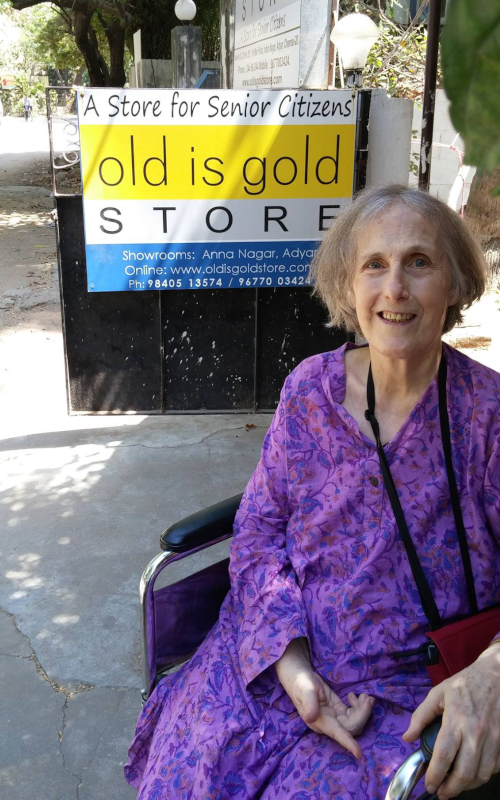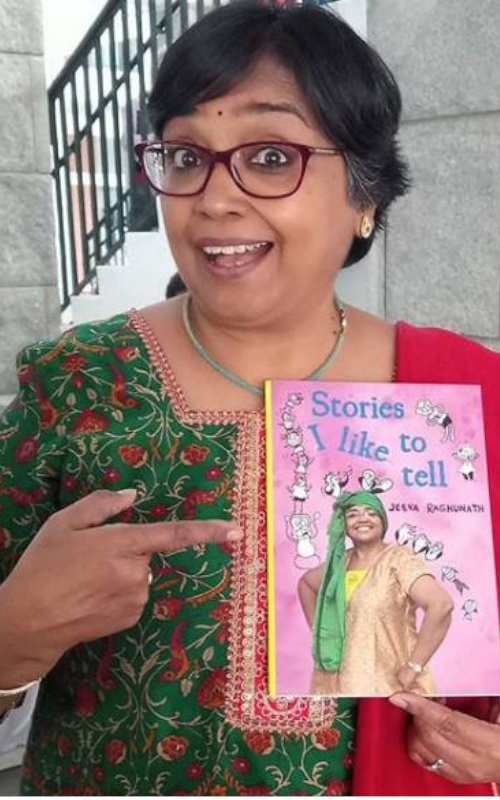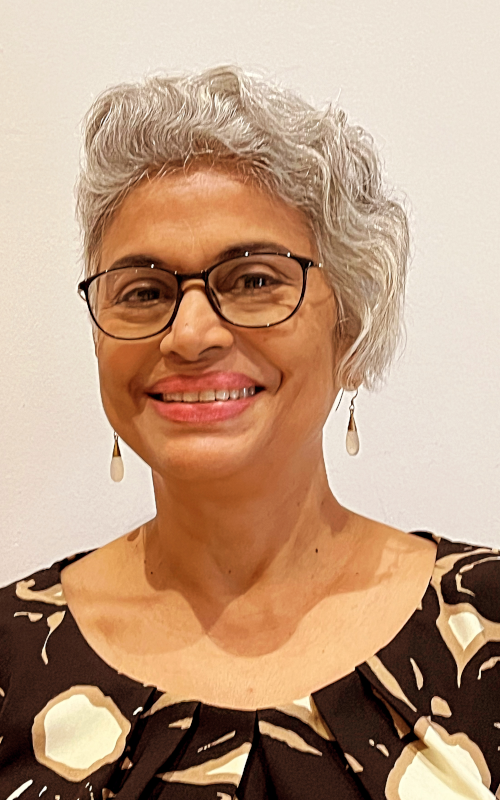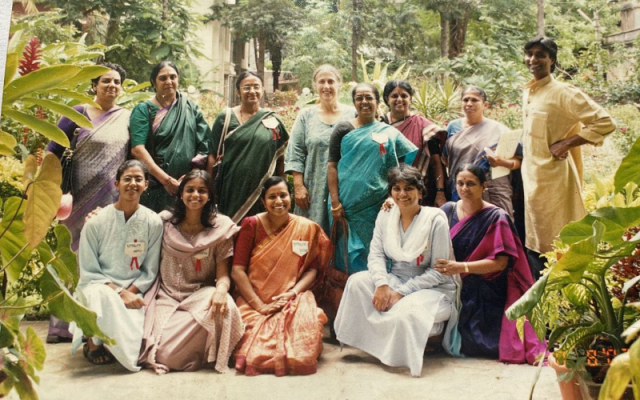
Author and storyteller Cathy Spagnoli knew how to make room in her audience’s hearts with her stories. And she passed that art on to others.
Since 1977, I have been supporting myself, and usually my family, through storytelling and writing. It’s a great way to make a living and has taken me throughout Asia and the US. That line is from Cathy Spagnoli’s facebook page.

That avenue, more or less, was closed off after a shattering diagnosis of brain cancer, 15 years ago. But Spagnoli’s was one of those indomitable spirits who do not stop learning new things. Consider this gem from her facebook life events page that she wrote around 2017: The last nine years have been harder since I got brain cancer. But I’m still here, learning social media and writing the story of my life, which has been quite an unusual one. It’s great to be back! Nine days ago the world lost this great storyteller.
The Learner who Taught
A storyteller and a mentor to storytellers who had a special and lasting connect with Asia and, more specifically, India. When Cathy began telling a story the audience listened. “They always listened to her with undivided attention, like they did on that one fine day in late 1970s, under the banyan tree at the Krishnamurthi School in Chennai,” reminisces Radhika Menon, publisher, Tulika.
Menon’s association with Spagnoli had the publisher’s angle to it. Tulika has published three of Spagnoli’s 10 books written for children and two resource books for aspiring teachers and storytellers. “She was always a storyteller. And that’s the voice that came across in her writing. Her books, The World of Indian Stories and The World of Asian Stories that Tulika published were great resource books for storytellers. She was a natural teacher,” says Menon. In 2000, she wrote up a compilation, Terrific Trickster Tales from Asia, many of the stories not available before in English. The book is aimed at the middle school student and includes hints about storytelling and projects to try.

Teacher apart, Spagnoli was a great innovator. One of her books, Priya’s Day is a fun story created from just one sheet of scrap newspaper. Spagnoli’s fingers worked magic with the paper, turning it into a kite, a cone of peanuts, a bird, and much more. It was a book created from a storytelling session.
Jeeva Raghunath, one of India’s best-known and loved storytellers, has this anecdote about Priya’s Day. The book was translated into Tamil by Raghunath, who was at one time the marketing manager of Good Books, the marketing unit of Tulika. This must have been sometime around 1998. The publishers had arranged for a teacher’s workshop to use Spagnoli’s resource book Telling Tales of Asia. The participants were teachers from private schools. As Raghunath’s narrative goes, Tulika had sent out an invitation to the government schools but they hadn’t responded. Just when the workshop began, 30 government school teachers joined in and they knew only Tamil.
“At that moment, Cathy looked at me and said ‘Jeeva, run the workshop in Tamil for them, while I do it in English.’ Spagnoli’s faith in Raghunath came from just having watched Raghunath perform from one of Spagnoli’s books. The book in question? Priya’s Day. “The trust she had after watching me perform Priya’s Day in Tamil gave me goose-pimples. The book that made me a professional storyteller 25 years ago. I owe all my storytelling life to her,” says Raghunath simply.
As a learner, Spagnoli would pick up pointers from every situation. There is one from 1992, for example, mentioned in her facebook entry. “I got an incredible opportunity to share American stories with Asian audiences. I gave many workshops and programs, at times collaborating with Asian musicians. But after my first programme in Pakistan, the USIA contact told me that I had used too much material on India. So I practiced furiously that night, taking out everything on India. She was much surprised and quite grateful! And so was I, for I had learned something very important.”
Spagnoli’s life was nothing if not full of adventure. She writes about her first journey to India. “In 1968, I started school at Tuft University and went for two years then left to go off overland to India, got hepatitis, got arrested, met amazing people then returned to finish my BA with Honours, in three years (total) by building a playground, teaching dance to the hearing impaired, and more.”
It was just the beginning.
The Globe-trotting Gatherer
Spagnoli includes stories from Japan, India, Korea, Vietnam, Cambodia, the Philippines, Bangladesh, Laos, Tibet, Pakistan, Sri Lanka, China, Indonesia, Taiwan, Burma, and Nepal in her repertoire. Spagnoli’s fascination with stories drove her to travel the world, search for stories and collect them in her little knapsack of stories. This blurb from Spagnoli’s book, Asian Tales and Tellers, says it all. “After profiling modern Asian storytellers practicing traditional storytelling styles, she arranges the stories around dominant Asian themes such as harmony and friendship, charity and simplicity; hard work and study; as well as faith and belief.”
In 2003, she toured Japan for a month with Japanese storyteller Kazu Honda, both telling stories together. “We went to places large and small, and had a grand time sharing our two cultures and languages,” she writes. Visiting traditional Japanese inns to listening to local stories, travelling to mountain temples to meet with monks, sliding through paddy fields hunting down storytellers, and spending time in classrooms in India kept her on the move. Her marriage to Indian sculptor Parasivan Samanna cemented the Asian and Indian connection.

Korea was another of her favourite places. In 1997, she was given a four month fellowship to study Korean storytelling and culture. I stayed in temples, homes, college dorms, and met an amazing range of tellers, writers, teachers, parents, and others eager to share their rich culture with Americans, she writes on facebook. Spagnoli returned in 2006 for a two-year stint teaching storytelling in Hannam University, Daejeon.
Alicia Dongjoo Bang, a Korean storyteller who has performed globally, explains that Spagnoli’s storytelling legacy is one that inspires the world. Dongjoo Bang, who is also the president of KISA (Korea International Storytellers’ Association), says, “As a storyteller, Cathy conveyed the wonder of the world to children through her narratives and imparted the wisdom needed for them to navigate life. Cathy collected a myriad of Asian stories and, by sharing these stories with children around the world, she instilled pride in storytellers who celebrated the richness of Asian cultures.”

One of Dongjoo Bang’s favourite titles is Nine-in-One Grr! Grr! translated into Korean by another well-known Song Young-sook. “I am committed to continuing to share her stories with children in Asia and around the globe. Cathy will forever be remembered as a beautiful storyteller who enriched Asian tales in the hearts of many Korean storytellers. I have never worked with Cathy, but I know her because she lived in South Korea and I bought her books. I have always wished to meet her,” she says.
“Cathy’s storytelling was simple and intelligent, gentle and humorous, and naturally warm,” remembers Singaporean storyteller Rosemarie Somaiah adding, “it made her stories accessible and put people at ease.” This characteristic of Spagnoli’s stood true for many of her inter-personal relationships too. Raghunath, recounts one such experience when she along with Spagnoli and her son Manu, who was a kid then were travelling to Delhi. “We went to the accommodation and found that it was not liveable at all. She looked at me. I looked at her. Neither of us knew Delhi. Cathy being Cathy didn’t want to fuss. I took the hint and quickly invited her to stay with my sister. It wasn’t a big apartment and my sister apologised for not giving her the best comfort for which Cathy said ‘It’s not the space in the house but the space in your heart which is big enough for a whole family to live.’ My sister was moved. She felt so much at home.”

The Legacy
Spagnoli’s genius lay in the fact that she never allowed the performance to overpower the purpose of the story. Menon agrees that this was Spagnoli’s special technique as a storyteller – with no drama or histrionics. “It was always a low-key, understated style. She would use a guitar and the story would just flow,” remembers Menon. For Somaiah, this was something important that she herself carries within her. Spagnoli’s connect with children came quite naturally.
Says Somaiah, “Cathy used gentle humour to hook children. For example, she might tell a funny folktale about simple bodily functions which children are curious about, but which adults might not usually mention in public. She did it with tact, before such stories became mainstream in publishing. Once she had their attention, she could follow up with another more reflective story.” According to Raghunath, Cathy was “gentle, but firm. Her twinkling eyes and clarity made children listen to her eagerly.”

Cathy had a natural, organic connect with children, points out Menon. “She related to them one to. In one sense a Western way of relating to kids unlike us,” she says.
According to Geeta Ramanujam, founder and director of the Bengaluru-based Kathalaya’s International Academy of Storytelling, storytelling was Spagnoli’s life. From the moment the two met in 1998, Ramanujam became a Spagnoli fan. “She inspired me the moment I watched her in action. I had begun a basic course in Storytelling when I invited her to the workshop. She sent us a huge consignment of books from a library in the US,” remembers Ramanujam. Spagnoli never forgot a good turn. Ramanujam also mentions a letter that she received from Spagnoli referring to Ramanujam’s write up in the Deccan Herald. ‘Your article on me was seen by a visitor from Singapore and it resulted in an invitation for me to go to Singapore. Thank you for that.’
Spagnoli’s work was like that pebble thrown into a pool. It created waves in many directions – inspiring, teaching, motivating people from around the world. Her arrival in Chennai, which became second home after Vashon in the US, opened the floodgates for a revival of storytelling in Tamil Nadu. Raghunath calls her the “Godmother of Storytelling in India”. For Somaiah, it was Spagnoli who showed her the possibilities of various art forms and gave her courage to pursue this path. Spagnoli played a significant role in the formation of the Storytellers Circle in Singapore, which is still going strong.

The cancer could not stop her travels to India completely. The latest one was a wheelchair-bound trip in 2019, following one in 2015. She spent time at her favourite spot – the Cholamandal Artist’s Village near Chennai. In the end, the only thing that could terminate Spagnoli’s effervescence, drive and adventurous nature stopped her.
The baton has passed. It needs to be carried on. And it will.


